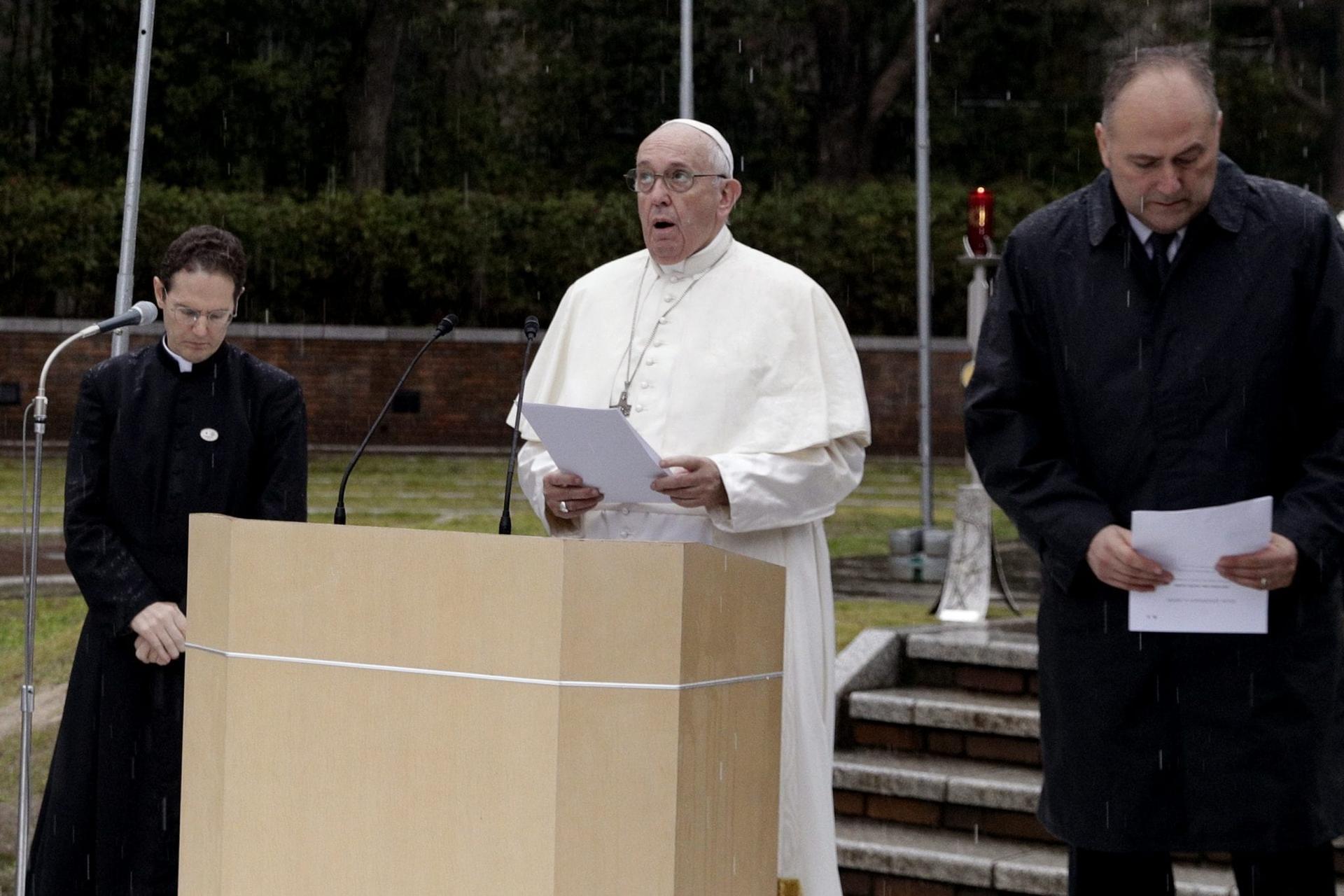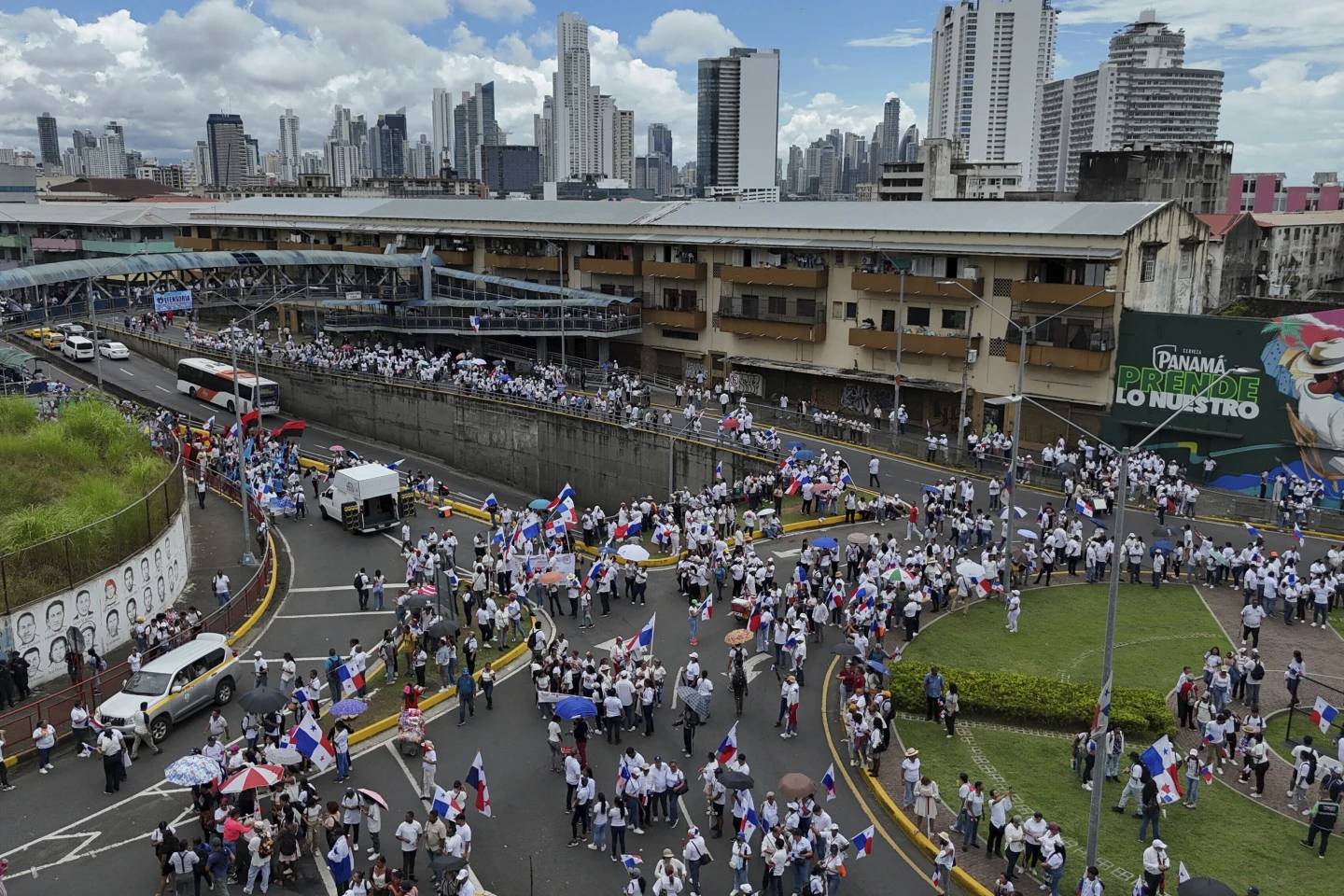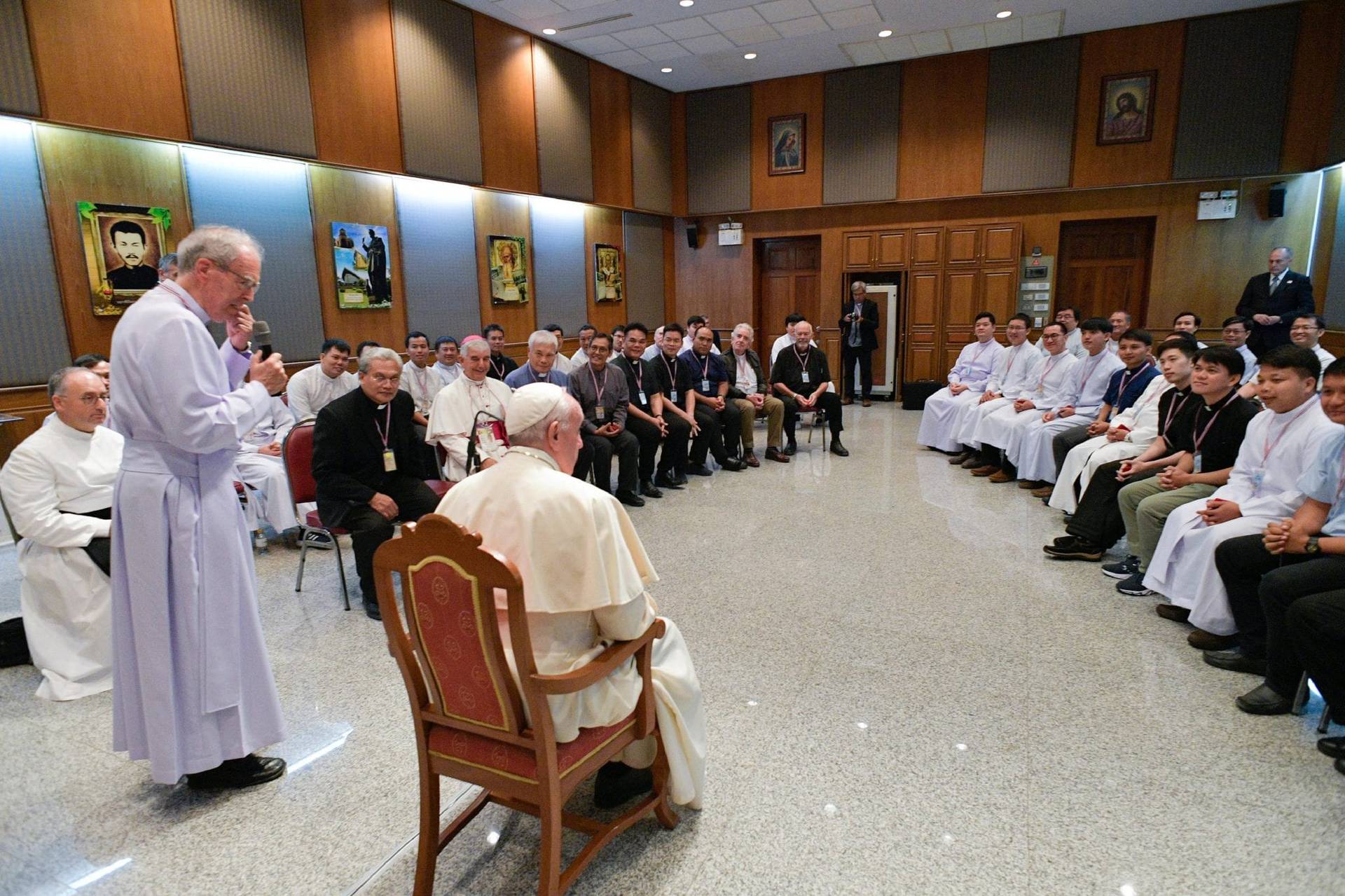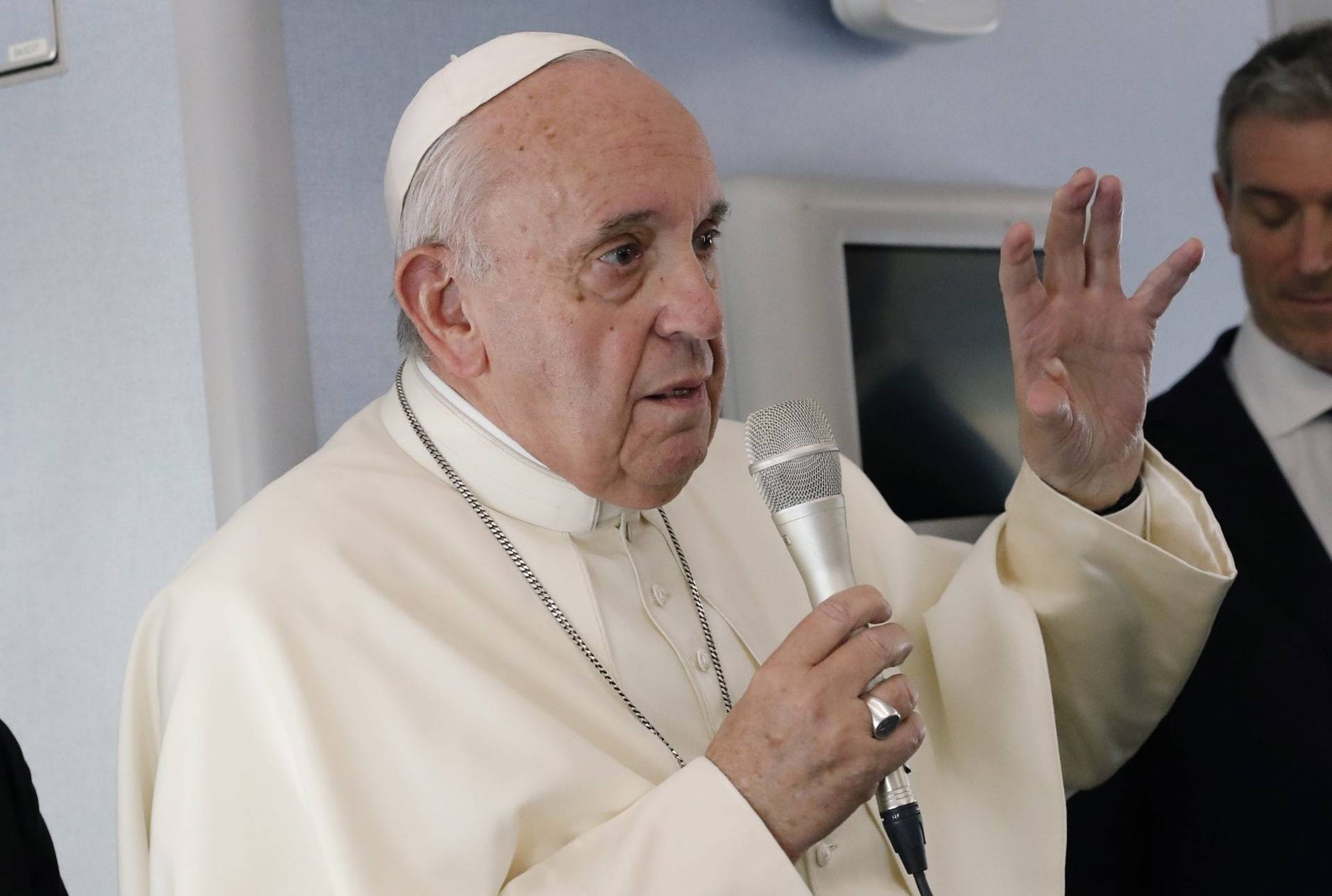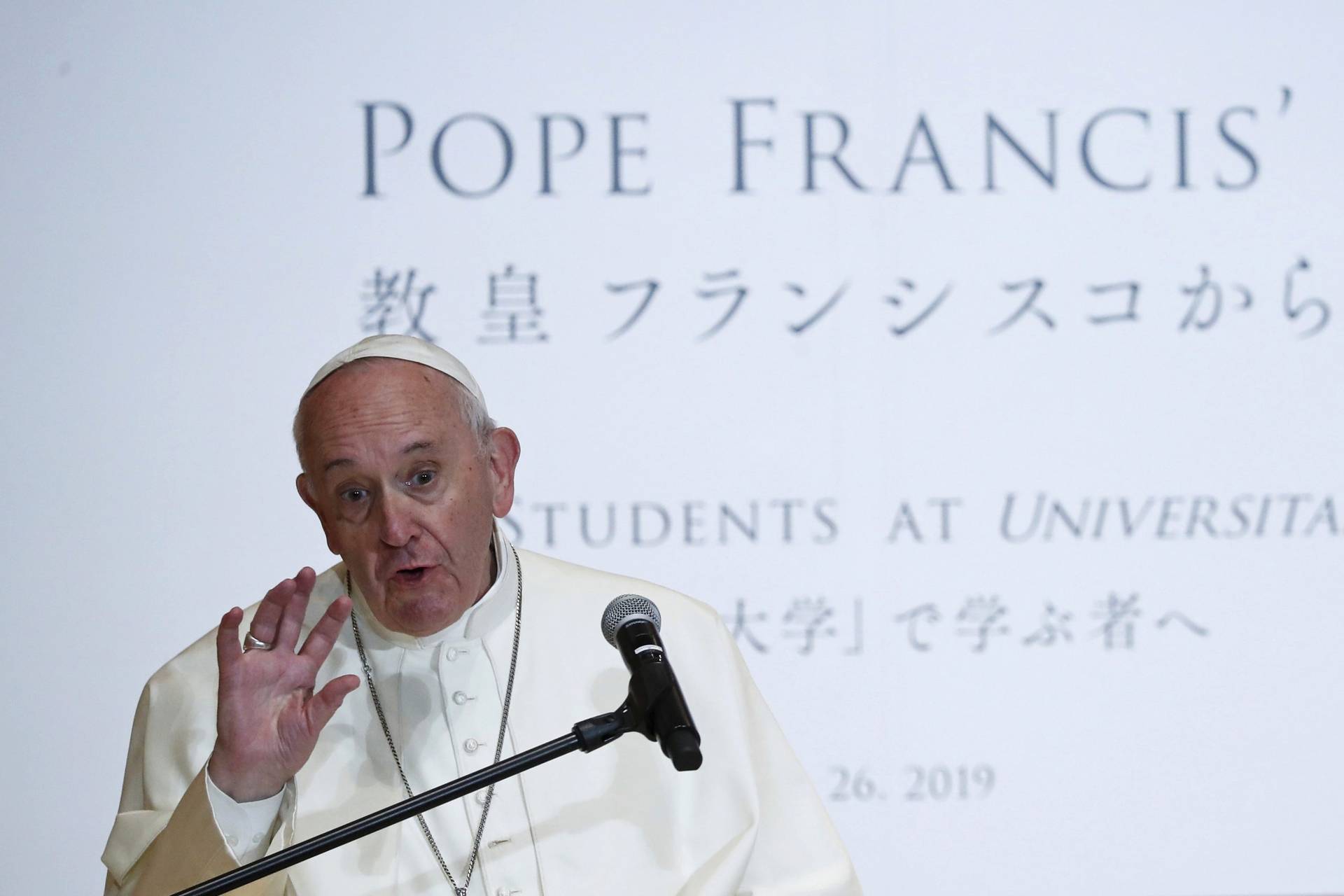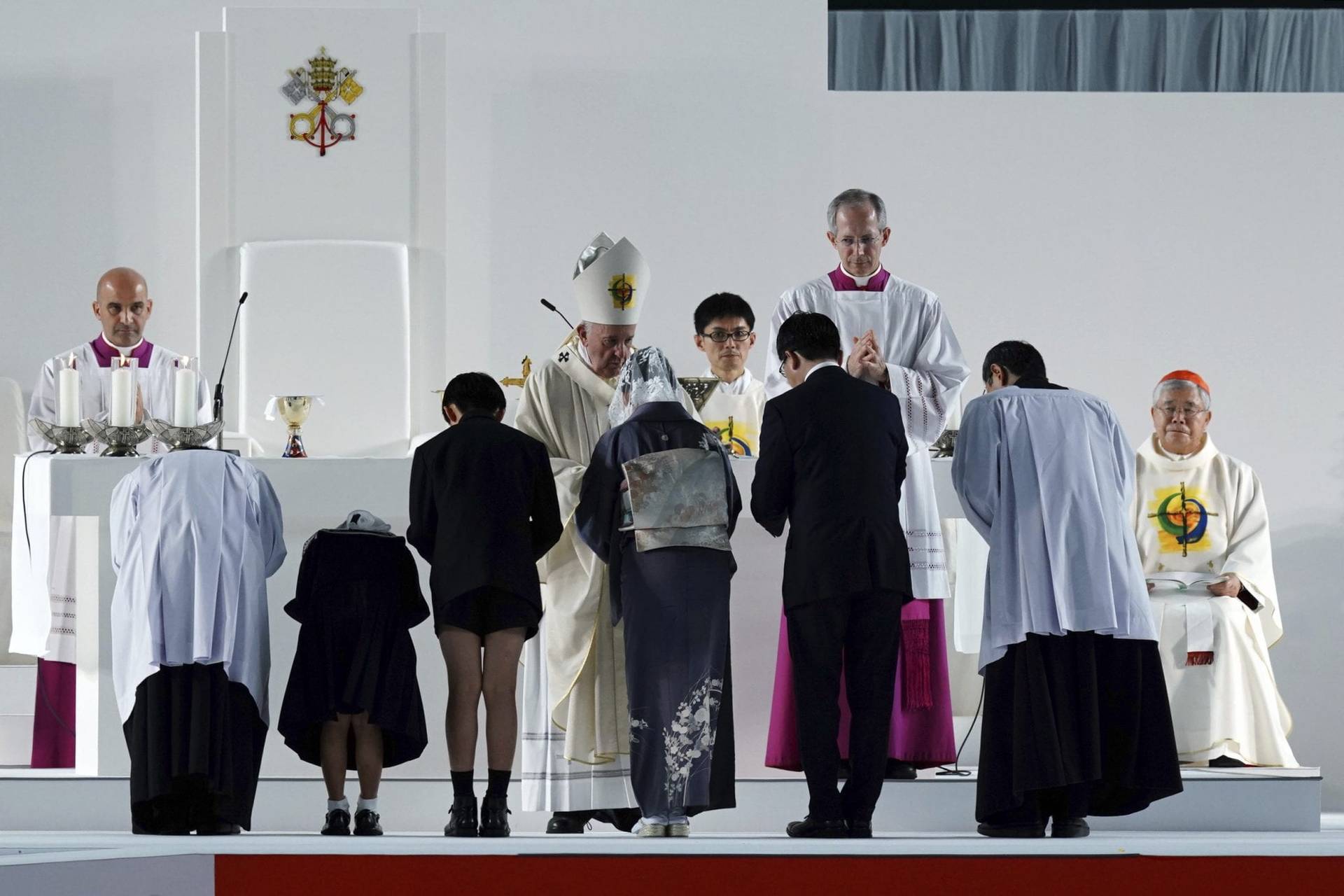NAGASAKI, Japan – In perhaps the most anticipated of the 18 speeches Pope Francis is scheduled to deliver during his Nov. 20-26 tour of Thailand and Japan, on Sunday in Nagasaki the pontiff called for total divestment from weapons of mass destruction and for military funds to be used to help poorer nations.
“No one can turn a deaf ear to the plea of our brothers and sisters in need,” he said. “No one can turn a blind eye to the ruin caused by a culture incapable of dialogue.”
The pope spoke during heavy rain, taking shelter under a small makeshift tent with an image of a young boy in Nagasaki after the 1945 nuclear blast carrying his dead brother on his back in line at a crematorium. In December 2018, Francis asked the Vatican Press Office to distribute copies of the image, titled “The Fruit of War.”
The fact that money is “squandered” and fortunes are made through the “manufacture, upgrading, maintenance and sale” of destructive weapons as millions of children and families live in inhumane conditions, Francis said, represents “an affront crying out to heaven.”
“Here in this city which witnessed the catastrophic humanitarian and environmental consequences of a nuclear attack, our attempts to speak out against the arms race will never be enough,” he said. “The arms race wastes precious resources that could be better used to benefit the integral development of peoples and to protect the natural environment.”
The pontiff argued that “the fear of mutual destruction, or the threat of total annihilation” amounts to defending stability and peace through a “false sense of security” sustained by a mentality “that ends up poisoning relationships between peoples and obstructing any form of dialogue.”
“One of the deepest longings of the human heart is for security, peace and stability,” Francis said on Sunday, visibly moved by the stage that surrounded him as he delivered a speech labeled by the Vatican as “on nuclear weapons.”
“The possession of nuclear and other weapons of mass destruction is not the answer to this desire; indeed they seem always to thwart it,” he said.
The pope’s anti-nuclear weapons message was delivered in the Nagasaki Atomic Bomb Hypocenter park, as he stood next to a black granite monument erected in 1968 to mark ground zero. Before the monument, there was a stone box containing a copy of the name list of the bomb’s victims.
Francis’s call for a world free from nuclear weapons is in alignment with his predecessor, St. John XXIII, who in his 1963 encyclical letter Pacem in Terris urged the prohibition of atomic weapons and also stated that lasting international peace “cannot rest on a balance of military power, but only upon mutual trust.”
For this ideal to become a reality, Francis argued, everyone has to be involved, from individuals to religions, including countries that possess weapons of mass destruction and those that don’t, the military and the private sector, and international organizations.
“Our response to the threat of nuclear weapons must be joint and concerted, inspired by the arduous yet constant effort to build mutual trust and thus surmount the current climate of distrust,” he said.
Hiroshima was the first city in the world to suffer an atomic bomb. On August 6, 1945, at 8:15 a.m., the weapon was dropped on the city by U.S. bombers. Some 43 seconds later it exploded above the ground, generating a mushroom-shaped ball of fire. Thousands died instantly due to the high temperatures. Two miles from the epicenter, people’s skin was burned and telephone poles, trees and all other wood materials charred.
The bomb that devastated Nagasaki came three days later, at 11:05 a.m. local.
Although acute radiation disorder subsided 5 months after the detonation, various radiation-induced symptoms appeared many years later, causing victims to suffer for a prolonged time.
Calling for the promotion of peace between peoples, Francis said the Church is “irrevocably” committed to this cause. The institution, he said, must never “grow weary of working to support the principal international legal instruments of nuclear disarmament and non-proliferation, including the treaty on the prohibition of nuclear weapons.”
Yet the efforts of the Church are not enough: the pontiff also called upon leaders of the world to acknowledge that nuclear weapons “cannot protect us from current threats to national and international security.” Instead, he said, there’s a need to “ponder the catastrophic impact” of their deployment, particularly from a humanitarian and environmental point of view, rejecting the “mistrust and hostility fomented by nuclear doctrines.”
Calling on all peoples to work toward implementation of the United Nations’ 2030 sustainable development goals, he quoted Pope Paul VI, who in his 1964 Populorum Progressio called for the establishment of a global fund to help the neediest of nations, to be sustained partially from reduced military expenditures.
Though some observers have labeled Francis’s decision to visit Nagasaki and Hiroshima “historic,” the truth is that it’s not without precedent. Thirty-eight years ago, St. John Paul II made his own “Appeal for Peace” when he visited Hiroshima as a “pilgrim of peace,” sounding the alarm against the nuclear arms race.
In the Peace Memorial Museum in Hiroshima, where Francis is scheduled to visit later on Sunday, there’s an epigraph with an inscription of the late pope’s appeal, both in Japanese and in English: “War is the work of man. War is destruction of human life. War is death. To remember Hiroshima is to abhor nuclear war.”
Ever since John Paul II visited Japan, the local church has organized a yearly “ten days for peace” initiative, which sees thousands of faithful from all over the country travel to Hiroshima and Nagasaki to participate in Masses, memorials and other events. The pontiff underlined the importance of this initiative during his appeal.
Built between 1950 and 1955, the Nagasaki peace museum is a World Heritage place, designed as a witness to Japan’s commitment to rejecting war, a principle stipulated in the country’s constitution, article nine.
Francis was scheduled to visit the Hiroshima Peace Memorial park later on Sunday, after honoring the Japanese martyrs and saying Mass for thousands in a baseball stadium in Nagasaki.
Remembering Japanese martyrs, an appeal for the martyrs of today
After delivering his message against nuclear weapons, Pope Francis headed to Nishizaka Hill in Nagasaki where 26 Christians were crucified over 500 years ago, marking the beginning of a bloody persecution of Catholic missionaries and faithful that lasted two and a half centuries
After praising their courage, Francis noted that there are Christians throughout the world who, “in our day, suffer martyrdom for the faith.”
“They are martyrs of the twenty-first century, and their witness summons us to set out with courage on the path of the Beatitudes,” he said. “Let us pray with them and for them. Let us speak out and insist that religious freedom must be guaranteed for everyone in every part of our world.”
Some estimate that over 200 million Christians a day face the threat of harassment, persecution, arrest, torture and even death on account of their faith.
The Monument of the Martyrs was recognized by Pope Pius XII as a sacred place worthy of pilgrimage in 1950. It’s located on the site of their execution, which today has become a memorial park with a bronze relief monument to the martyrs inflated in a red granite base.
Many Catholics in Japan today descend from the “hidden Christians” who survived the persecutions. Japan is a largely Buddhist and Shinto country, where Catholics represent 0.3 percent of the total population.
During his remarks at the monument of the martyrs in Nagasaki, Francis referred to the Document on Human Fraternity, which he signed last February in Abu Dhabi along with the Grand Imam of Al-Aznar and other religious leaders from around the world.
“Let us also condemn the manipulation of religions through `policies of extremism and division, by systems of unrestrained profit or by hateful ideological tendencies that manipulate the actions and the future of men and women,” he said.
Follow Inés San Martín on Twitter: @inesanma
Crux is dedicated to smart, wired and independent reporting on the Vatican and worldwide Catholic Church. That kind of reporting doesn’t come cheap, and we need your support. You can help Crux by giving a small amount monthly, or with a onetime gift. Please remember, Crux is a for-profit organization, so contributions are not tax-deductible.
